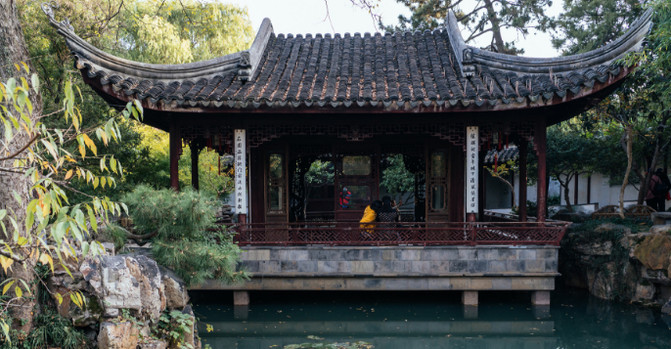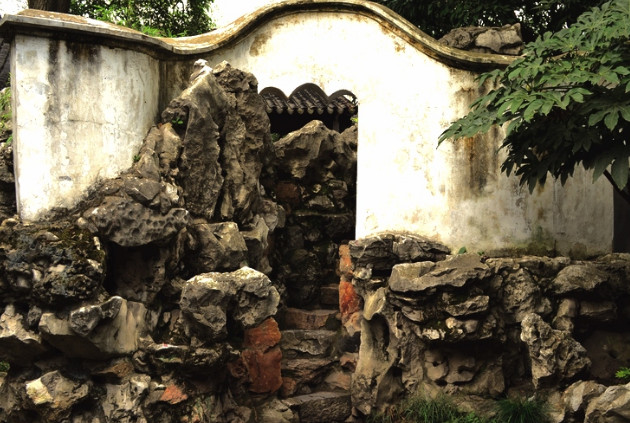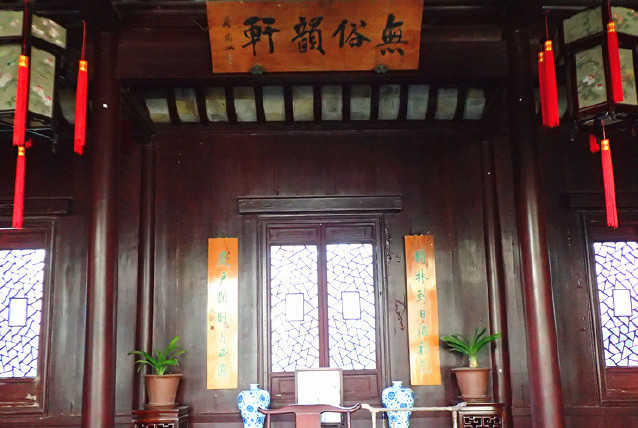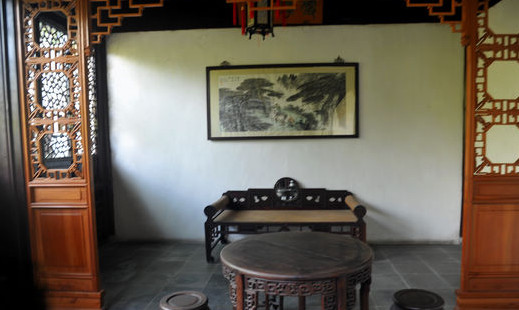Qiyuan, an isolated example in Suzhou's classical gardens
★ Tourist location: Suzhou Yiyuan
We were actually deceived by the driver when we went to Qiyuan, because we thought that driving in the Urban area was not as convenient as taking a taxi. Anyway, the Master of Nets Garden and Canglang Pavilion were not far away. As a result, the driver said that the garden was beautiful and unique, the tickets were cheap, and not many people went. At night, you could also see the night view of Pingjiang Road. Of course, the most important thing was that we were a little greedy for the delicious food on Pingjiang Road, so we unanimously gave up the original plan and let the driver drag us and our group to the gate of Jianyuan. In fact, there are many tourists in Qiyuan. In the past two years, the publicity has gradually caught up. When tourists go to Pingjiang Road to enjoy delicious food, they don't forget to come here to admire the Suzhou gardens.
Jiyuan was built during the Yongzheng period of the Qing Dynasty. Lu Jin, the prefect of Baoning, resigned from office and returned to his hometown. This garden was built, formerly known as Sheyuan, or Xiaoyu Forest. The name of the garden comes from Tao Yuanming's "Guici","The garden is involved in the day to become interesting." During the Xianfeng period, Sheyuan was destroyed by soldiers. During the Tongzhi period, Shen Bingcheng, the magistrate, lived in Suzhou due to illness. He took his wife and went into seclusion. He rebuilt and expanded the garden, and changed its name to Yuyuan. The word "couple" means "even", and the origin of the name of the garden is because the garden has a garden built on the east and west of the house. At the same time, it also means that the couple both go into seclusion and sing their old age. In the tenth year of Guangxu, Shen Bingcheng was ordered to return. He died of illness 21 years later and died in Wuyuan. Later, it gradually became abandoned and became a residential building. Later, educators Zhao Shanchang lived here together with Chen Shihong, Shen Ziqi, Zhang Yingu, Zhang Weinong and Wang Qiyu.
In the 28th year of the Republic of China, Qian Mu, a master of Chinese studies, welcomed his mother to live in the East Garden, and his eldest nephew Qian Wei also lived in the garden. Later, Liu Guojun, a Changzhou industrialist, purchased the Yeyuan and repaired it again. In the 1950s, the central hall of Jianyuan was destroyed by a fire. In fact, almost all of it had become residential buildings at that time.
The garden faces the river on three sides and along the street on one side. The door opens to the beautiful scenery of the Jiangnan water town with small bridges and flowing water. This is rare in many gardens in Suzhou. The garden has a total area of 8,000 square meters. The plan view looks similar to a rectangle, with a length of 110 meters from east to west and a width of 78 meters from north to south. With the four-entrance halls as the center of the homestead, the east and west gardens are connected by a large building, which can be roughly divided into three parts: the middle hall, the west flower hall and the east garden.
There is a large archway at the entrance, and you walk through a small bridge to the gate of Jiyuan. On both sides is a couplet: "Living in a garden is a good couple, and building a city of poetry is a song." It is said that this was written by Mrs. Shen Bingcheng. It can be seen that the so-called match of families in ancient times was not only due to the same family background, but more importantly, only because two people from the same aristocratic families could achieve harmonious singing. If a woman is truly virtuous if she has no talent, she can only blink and fail to respond. Can the two get along harmoniously? It can be seen that Shen Bingcheng and his wife are really a perfect couple. No wonder they have made the story of hiding together in Shuangshan. The two of them lived in seclusion as happy as immortals.
The middle hall is a residential area, with a foyer, sedan hall, lobby and balcony in turn on the central axis. Magnolia is planted outside the gate building, and golden osmanthus is planted inside the gate building. Together, it is a "full house of gold and jade". The door of the hall is wide inside and narrow outside, looking very low-key, and also paying attention to Feng Shui. It is said that it gathers inside rather than outside.
The sedan hall is a place for the sedan chair and the sedan chair bearers to rest. The inscription is "Urban Mountains and Forests", and there are couplets on both sides: "Being free and free outside the city is like being between mountains and rivers." This was written by Deng Shiru, a literator in the late Qing Dynasty.
The wine-carrying hall is the place where the owner uses to entertain guests and conduct meetings. It is separated from the rear hall by a wall door. This is a second door. Ancient ladies could not walk through this door. The brick carvings on the top floor of the gate are very exquisite, with a total of three floors. They are three-dimensional opencut and are inscribed with the title "Poetry and Wine Gala".
The back building is where the family lives. The courtyard is very large, with side buildings in the east and west, forming a concave shape. The main building is connected to the east and west sides, and the side buildings are connected to the east and west gardens. This is called the "Zouma Tower" in the structure of Jiangnan Mansion.
The corridor on one side of the wine holding hall leads to the East Garden. There are Mrs. Shen Bingcheng's calligraphy on the corridor, which shows that Shen Bingcheng appreciates his wife's knowledge quite a lot. Next to it is the Wuxian Yunxuan, which is said to be the study built by Shen Bingcheng's wife. Wisteria and crape myrtle are planted in the yard. The two plants named after purple mean "purple gas coming from the east".
Walking through a zigzag veranda is the East Garden, which is also the essence of the Garden. Covering an area of about four acres, the layout is mainly mountains and supplemented by ponds.
Mountain refers to the Yellowstone rockery, which is different from the rockery in Lion Grove. Although the scale is not so large, it is majestic and simple, steep and steep. The middle is divided into east and west parts by the deep valley. The east is relatively large, and the main mountain is steep. The western secondary mountain is slightly lower and lowers step by step from east to west. The eastern peak turns into a cliff and goes straight down into the pool. This stone-stacking technique is natural and realistic, making it the most rockery of its kind in Suzhou. Contemporary architects believe that it is almost no different from the Huangshi rockery in Shanghai's Yu Garden. Even if it is not the work of Zhang Nanyang, a famous garden builder during the Jiajing period of the Ming Dynasty, it is probably the same origin and may be the original thing originally involved in the garden.
Generally speaking, there are buildings such as pavilions built on the top of the mountain, but there are no buildings on this Yellowstone rockery. Instead, some flowers and trees are planted. This is a real seclusion among the mountains and forests, although in fact people are also hidden in the city.
The pool is a moon-receiving pool. Although it is not very large, it is said to be the only pool in the existing Suzhou gardens that is connected to the outer river and closely connected to the urban water system. The folded bridge above is only three-fold, and the water pavilion "Shanshui Room" is built across the pool at both ends. It is really between the rockery and pool. The floor-to-floor cover is carved with pine, bamboo and plum patterns on both sides. The regulations and craftsmanship are second to none in Wuzhong and may also be a relic of the Ming Dynasty.
The East Garden is surrounded by Huangshi rockery and moon-receiving pool, with some buildings scattered in a scattered manner. Starting from the rattan boat in the west, there is the Fragrance Storage Hall in the north, and three small courtyards in the northeast corner, collectively known as the "Chengqu Cottage". To the east are Wangyue Pavilion and Wuai Pavilion, and in the southeast corner are Shanshui Room, Kuixing Pavilion and Tinglu Tower.
It is quite interesting and straightforward to name the Lulu Tower. This is the junction of the two river courses. In the past, people relied on rowing boats to travel, and the sound of the city river's oars can be clearly heard upstairs.
Chengqu Cottage is the main building of the East Garden, with a span of 40 meters. It is a reading building complex in the style of a double-eaved pavilion. There are three halls in the middle hall. This was the place where the host family had banquets and gatherings in the old days. The couplet on the gate,"Lying on the stone, listening to the waves, full of loose colors, opening the door and watching the rain, listening to the sound of bananas", depicts the daily life of the garden owner and is full of poetry and painting. Listening to the sound of pine waves and watching the sound of bananas in the rain, this life is quite enjoyable. Of course, couples sing harmoniously even if they write poems and lyrics. The Shuangzhao Building in the east is a good place to enjoy the scenery of the whole park.
To the east is the Shuangzhao Building, which means that the sun and the moon shine twice. Shen Bingcheng's father, original wife Yao and two sons passed away one after another. As a result, he also suffered from liver and spleen diseases. The person who moved to Jiyuan with him was his stepwife Yan Yonghua. Both of them like poetry and Kunqu Opera, so they can reconcile poetry and poetry. Originally, I thought Chengqu Cottage was Chengqu referred to the geographical location of Wuyuan. Later, I learned that it was taken from a poem from Li He's "Dawn in Shicheng":"The female cow crosses the Tianhe River, and the willow smoke fills the city." This is clearly a show of love!
There are also many places to show love, such as my love pavilion and Wangyue pavilion, which are connected by a cloud gallery. The Yun Corridor and the Xianglu Corridor on the other bank face each other across the pool. One is the husband corridor and the other is the wife corridor. The name of my love pavilion is very straightforward, and the Wangyue Pavilion is also a place where the couple admire the moon.
The West Garden is small in area. In fact, the entrance to the Garden is in the West Garden. However, because we were eager to see the East Garden, we took a brief look at the West Garden and walked towards the middle hall.
When you enter the door, you can see a lake stone rockery and a white wall. The two are mixed together. There is a wall in the stone and a stone in the wall. This design is also unique. The rockery is not big, but it has mountains, cliffs and caves.
With the old house woven with curtains in the study room as the center, it is divided into two small courtyards in the front yard. There is a lake stone rockery in the backyard. There is a lake stone flower surface in the north of the garden. There is a platform in front of the Yuanyang Hall on the Hard Mountain Top. The courtyard in the south is irregular in shape, and the three-inch bungalows in the east.
There is a Heshou Pavilion in the east, and the half-pavilion on the top of the mountain is built against the wall. Behind it is a library building, which is quite large. It seems that the Shen family has a rich collection of books. At the south end, there is an orchid room with three rooms wide. Relatively speaking, the layout of the West Garden is relatively common and its scale is smaller than that of the East Garden.
The most special part of the garden is one house and two gardens. There are water ports and docks in both north and south. This gardening art is an isolated example in Suzhou's classical gardens. Coupled with the love story between Shen Bingcheng and his wife, the garden is also a garden that you can visit in detail.

































Previous Article:What kind of delicious food is hidden under this "Internet celebrity bridge" in Wujiang that makes people don't even want to be officials anymore
Next Article:Shigong Temple, where Master Hai Deng returned to his bones
